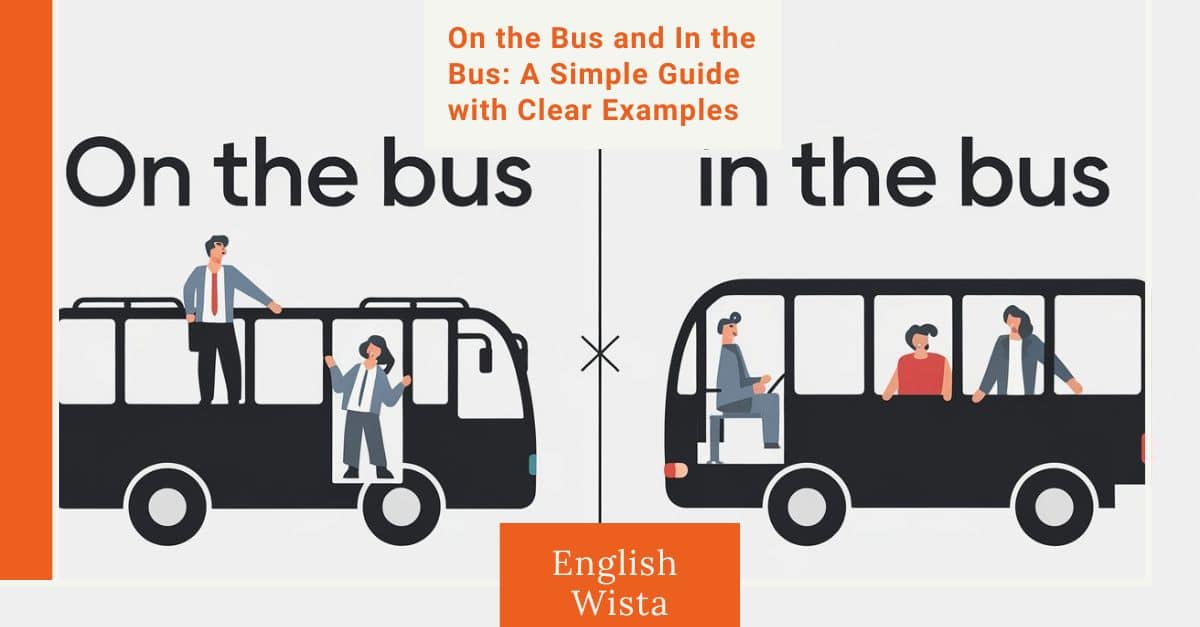Have you ever wondered if you should say “on the bus” or “in the bus”? It’s a small detail, but it can make a big difference in how you sound to native English speakers. Whether you’re chatting with friends, writing a travel blog, or just curious about language quirks, this simple distinction can be surprisingly important—and even a little fun to master.
You’re about to uncover why these tiny words—“on” and “in”—aren’t as interchangeable as they might seem. Ready to clear up the confusion once and for all? Let’s dive into the fascinating logic behind these phrases!
What’s the Difference Between “On a Bus” and “In a Bus”?
The key difference lies in how we think about the space. When we say “I’m on a bus,” we’re talking about being a passenger on public transport. It’s not just about the physical location but the experience of being part of a shared journey.
On the other hand, “in a bus” is more specific to the physical interior of the vehicle. It’s less about the shared experience and more about simply being inside the vehicle itself.
When to Use “On a Bus”
We use “on” with most forms of public transportation and larger vehicles where people move freely or share space with others. This includes buses, trains, planes, and ships.
Think of it like this: being “on” these modes of transport focuses on the idea of being a passenger or part of the transportation system.
Examples:
- I’m on a ride heading to work. (You’re traveling as a passenger.)
- She left her phone there. (Referring to public transport.)
- We’ll be on the train for two hours.
Notice how these examples emphasize the role of the vehicle as public transportation.
When to Use “In a Bus”
“In a bus” is used when you’re talking about being physically inside the vehicle. This is more common when you’re describing a specific situation, like checking for something inside or referring to the enclosed space.
Examples:
- The driver found my bag inside. (The bag was physically inside.)
- We stayed there because it was raining. (You’re focused on the interior as a shelter.)
- There’s a leak in the roof.
What About Other Vehicles?
The same logic applies to other vehicles:
- On a plane vs. in a plane: Use “on” when traveling, but “in” when talking about the interior.
- “I’m on the way to New York.”
- “There’s a problem in the cabin.”
- On a ship vs. in a ship: “On” means you’re a passenger; “in” refers to the physical space.
Why Is It “On” for Passengers?
This usage comes from the idea of older transport systems. Think of early buses or trains where passengers rode on top or on open decks. Over time, even as vehicles enclosed their passengers, the preposition “on” stuck around. It’s the same reason we say “on a train” or “on a boat” even if we’re inside.
Real-Life Scenarios: Choosing the Right Phrase
- Talking About Your Commute
Correct: “I’m on public transport.”
Unusual: “I’m in the bus.” (This sounds unusual unless you’re emphasizing the physical interior.) - Describing an Incident
Correct: “He forgot his wallet inside.”
Misleading: “He forgot his wallet there.” (This could imply the wallet is outside!) - Explaining Where You Are
Correct: “I’m waiting on public transport to leave.”
Correct: “I’m sitting inside, waiting for the driver.” (Here, both work depending on context.)
Quick Definitions: On vs. In
- On: Focuses on the idea of being part of a transport system.
- In: Highlights the physical interior or enclosed space.
Fun Fact: Prepositions and Public Transport
Did you know English uses “on” for public transport but “in” for private vehicles? For example:
- “I’m on a bus.”
- “I’m in a car.”
This difference reflects how public and private spaces are perceived in English.
Key Takeaways
- Use “on” when you’re a passenger.
- Use “in” when referring to the physical interior.
- Think of “on” as part of the transport system and “in” as describing a space.
Conclusion: You’ve Got This!
Understanding the difference between these phrases can feel tricky at first, but with practice, it becomes second nature. The secret is to think about whether you’re talking about being part of the transport system (“on”) or describing the interior space (“in”). Next time you’re catching a ride, you’ll know exactly which phrase to use! Happy learning, and keep practicing your English—you’re doing great!



